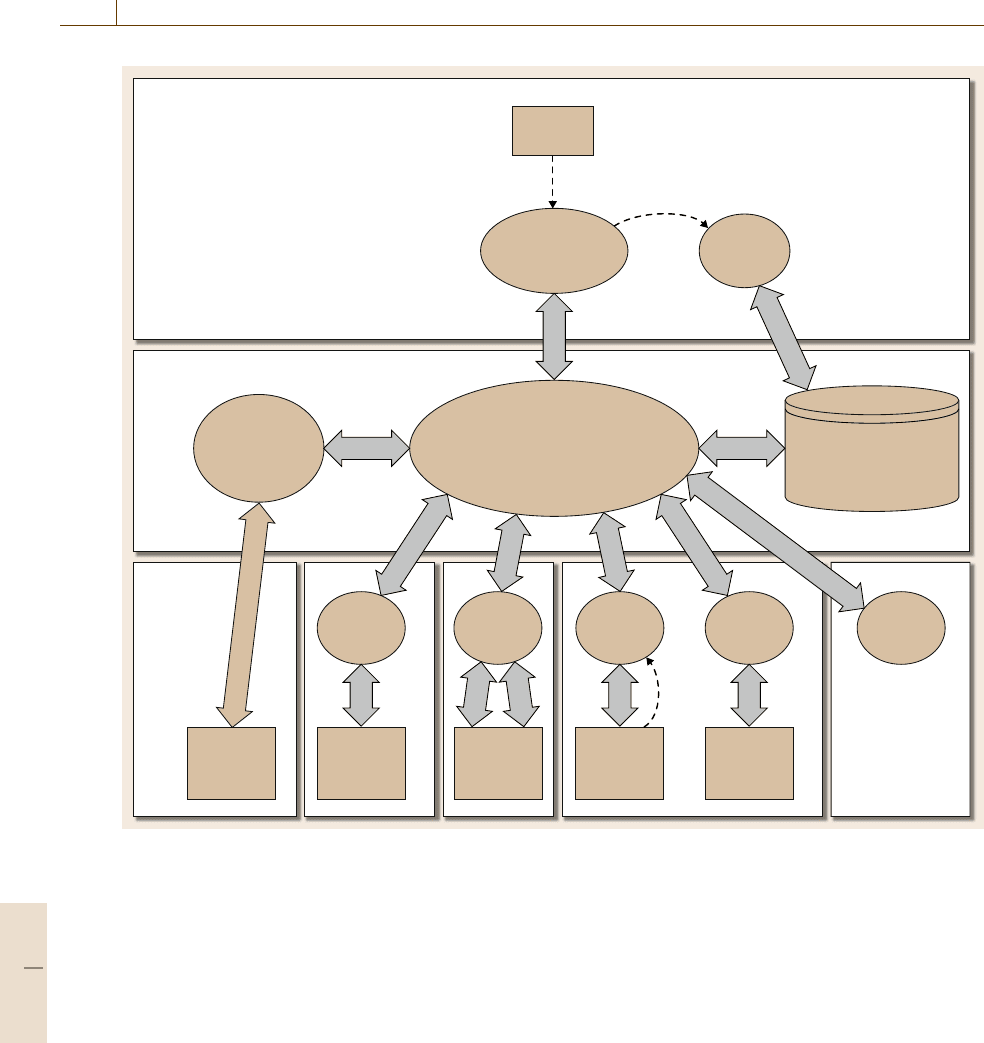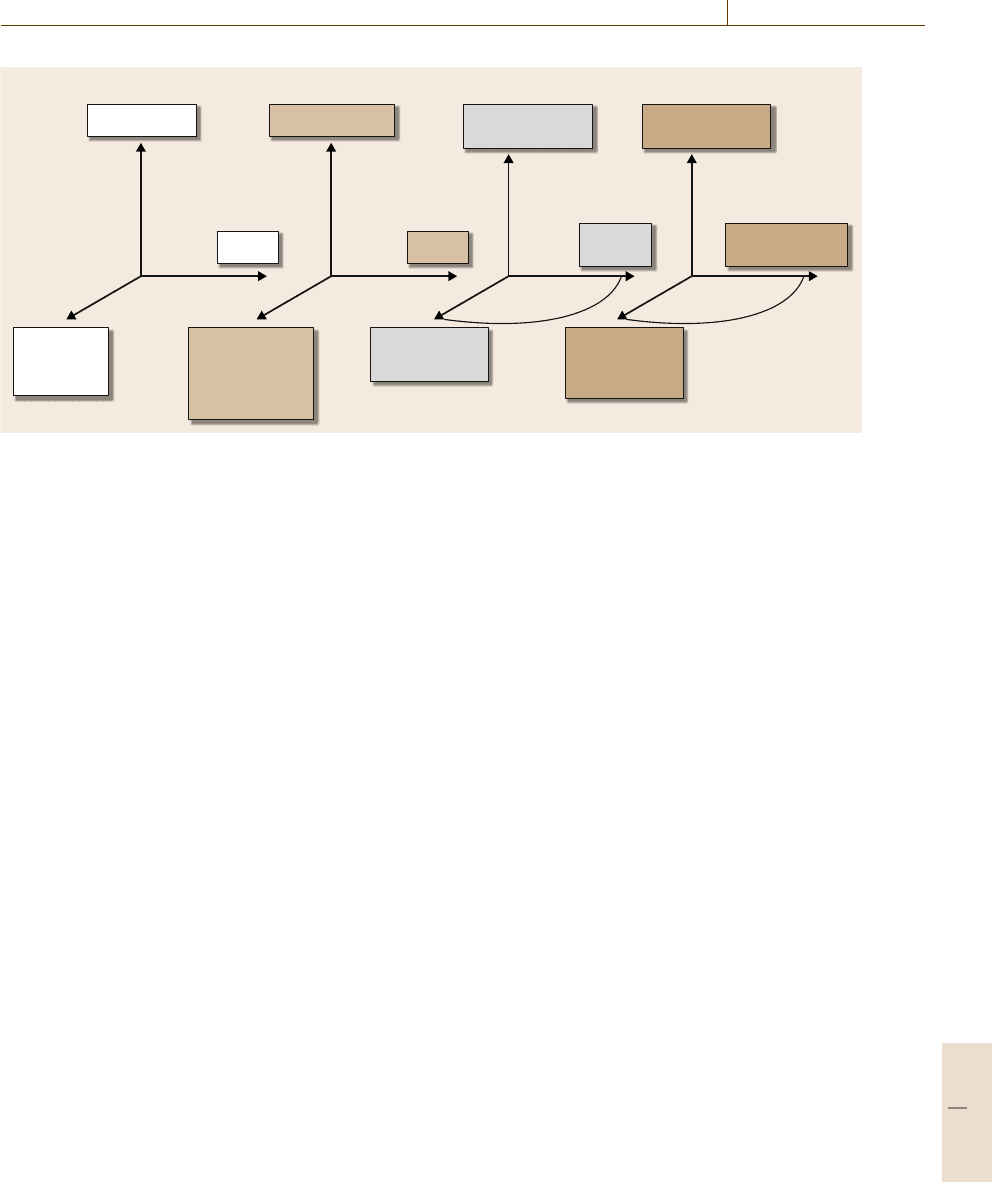Nof S.Y. Springer Handbook of Automation
Подождите немного. Документ загружается.


Practical Automation Specification 46.6 Example 805
Fig. 46.8 Layout of the test stand for
flow and heat meters
100 MBit/s Ethernet
Switch
PTB
PTB
intranet
intranet
100 MBit/s Ethernet
Industrial
Industrial
controller
controller
Simatic
Simatic
S7-400
S7-400
Network
printer
Process-
system-
automation
field
Temperature
detection
Individual treatments
of testees
(special treatments)
Evaluation balance
system
Time synchronization
Testees
Secondary-
standard
Flow
Pressure
Density
Humidity
GBIP/
Ethernet
PXI
comp.
testees
PXI
comp.
balance
system
Linux
server
VMK
system
SCADA
work-
station
SCADA
work-
station
SCADA
batch
server
OPC
server
DB
server
VMK
serial
VMK
serial
VMK
serial
VMK
Linux
VMK
Linux
VMK
Linux
VMK
Linux
Remote
maintenance
Remote
maintenance
Backup
system
Precision
DMV
Signal
condition
DMV
multiplex
Fig. 46.9 Specifying subsystems and their communication implementation (Seibersdorf Research) (VMK – measure-
ment interface, GBIP – general purpose interface bus, PXI – PCI extensions for instrumentation)
Part E 46.6

806 Part E Automation Management
Subsystems
Clients
Operator
Visualization
Access
mask
system
ODBC
Keithley
subsystem
E-net
E-net
RS232
RS485
NI-DAQ
VMK
subsystem
Waagen
subsystem
Counter
subsystem
Others
ODBC
OPC-tags
Synch.
signal
OPC-tags
Remote-tags
Industrial Ethernet
Remote-tags
Batch process
Simatic
OPC
server
Simatic
SPS
TEMP VMK Balance Counter
Oracle
database
Input mask
Server
Subsystems Subsystems Subsystems Subsystems
Operator
commands
Fig. 46.10 Specifying communication pyramid of the test stand (ODBC – open database connectivity, SPS – PLC,NI-
DAQ – national instruments – data acquisition)
46.6.1 System
Figure 46.8 depicts the layout of the test stand. The fa-
cility is built up on two floors. The upper floor houses
the test bench itself, the balance device with its self-
calibration unit, the diverter unit, and the elevated tank.
The pressure tank, compensation tank, pumping sta-
tions, and electrical heating device are installed on the
lowerfloor. Auxiliary equipmentsuch as the gasheating
unit and air cooling systems as well as compressor-
based cooling systems are in separate locations and are
not shown in the figure.
To get an impression of the dimensions, the linear
expansion of the system as depicted in Fig.46.8 is about
40m. The maximal testing flow rate is 1000m
3
/h. The
operation temperature is between 3
◦
C and 90
◦
C with
an installed heating capacity of 680kWh, an air cooling
capacity of about 1000kWh, a compressor-based cool-
ing capacity of about 380 kW h, and an installed pump
capacity of about 350kW h.
Part E 46.6

Practical Automation Specification 46.8 Further Reading 807
The technical requests for the commissioning were
at the limit of technical feasibility:
•
Stability of temperature in all operating points
< 0.1K
•
Stability of flow (up to 1000m
3
/h) < 1%
•
Stability of pressure (in pressure mode) < 3mbar
•
Accuracy of balance unit < 50g (on 20t of load)
•
Overall measurement uncertainty < 4×10
−4
.
These demands resulted in highest efforts to the control
and measurement system.
The key factor for the integration request was the
integration of the test stand management database (Or-
acle or MS SQL server (Microsoft structured query
language)) with its user front-end in the production
database that organizes the test routines and is respon-
sible for the storage of real-time trend data from the
testing process [46.11].
In these databases not only the test and test man-
agement data is stored, but also the complete setup and
control parameters as well as the calibration data of the
test stands measurement devices.
For exact repetition of tests all setup and control
parameters of the complete facility can be reloaded to
the subsystems automatically by recalling a certain date
or test order from the database. In additionally pro-
viding the necessary automatic documents for quality
control the customer owns not only one of the most
modern test stands in measuring technology, but also in
terms of data management.
Figure 46.9 shows the communicationof thesubsys-
tems. The control of the test stand itself and its auxiliary
systems is realized by an EN 61131-like PLC system.
This PLC system alone manages about 800 physical
I/O points on a centralized and decentralized basis. The
programming strictly follows the described equipment
structure.
46.6.2 Impacts
The first PLC implementation of this concept required
more effort and expense compared with traditionally
programming, but major benefits were observed already
during start of operation and integration into the vertical
environment.
46.6.3 Succession
Subsequently Profactor was put in charge of building
another, smaller test stand for a major German power
authority. Although Profactor was forced to use a lot of
different components compared with the PTB installa-
tion, the decrease of time, efforts, cost, and failures was
significant.
46.7 Conclusion
By following the described methods of implementing
an equipment-based control system structure, the sys-
tem designer is able to deliver software with a clear
hierarchical structure and a modular concept with
strictly defined interface layer architecture, simultane-
ously decreasing the required resources and increasing
performance, stability, and openness.
It is possible to implement a lot of con-
cept features normally only supported by object-
oriented languages. Most importantly, the engineer
can use existing software and hardware platforms
that have been available for many years and any-
where.
46.8 Further Reading
1. M. Frappier, H. Habrias: Software Specification
Methods: An Overview Using a Case Study
(Springer, Berlin Heidelberg 2000)
2. H. Ehrig: Integration of Software Specification
Techniques for Application in Engineering: Intro-
duction and Overview of Results (Springer, Berlin
Heidelberg 2004)
Part E 46.8

808 Part E Automation Management
References
46.1 G. Strohrmann: Automatisierungstechnik 1 (Olden-
burg, Munich 1998), in German
46.2 K.H. John, M. Tiegelkamp: SPS Programmierung mit
IEC 61131-3 (Springer, Berlin Heidelberg 2000), in
German
46.3 R.W. Lewis: Modelling Control Systems Using IEC
61499: Applying Function Blocks to Distributed Sys-
tems (Inst. Engineering and Technology, London
2001)
46.4 H.E. Eriksson: UML Toolkit (Wiley, New York 2001)
46.5 OPC Task Force: OPC Overview (OPC Foundation,
Scottsdale 1998)
46.6 Arbeitskreis Systemaspekte des ZVEI Fachverbandes
AUTOMATION: Die Prozessleittechnik im Spannungs-
feld neuer Standards und Technologien, J. Appl.
Test. Technol. 43, 53–60 (2001), in German
46.7 A. Dedinak, G. Kronreif, C. Wögerer: Vertical inte-
gration of production systems, IEEE Int. Conf. Ind.
Technol. ICIT’03 (Maribor 2003)
46.8 A. Dedinak, C. Wögerer, H. Haslinger, P. Hadinger:
Vertical integration of mechatronic systems
demonstrated on industrial examples – theory and
implementation examples, BASYS’04, Proc. 6th IFIP
Int. Conf. Inf. Technol. Autom. Syst. Manuf. Serv.
(Vienna 2004)
46.9 A. Dedinak, C. Wögerer: Automatisierung von
Großprüfanlagen am Beispiel eines Wärmezäh-
lerprüfstandes für die PTB,WhitePaper(ARC
Seibersdorf Research, Vienna 2002), in German
46.10 A. Dedinak, W. Studecker, A. Witt: Fully automated
test-plant for calibration of flow-/heat-meters,
Int. Fed. Autom. Control (IFAC), 16th World Congr.
(Prag 2005)
46.11 A. Dedinak, S. Koetterl, C. Wögerer, H. Haslinger:
Integrated vertical software solutions for industrial
used manufacturing and testing systems for re-
search and development (Advanced Manufacturing
Technology, London 2004)
Part E 46

809
Automation a
47. Automation and Ethics
Srinivasan Ramaswamy, Hemant Joshi
Should we trust automation? Can automation cause
harm to individuals and to society? Can individuals
apply automation to harm other individuals? The
answers are yes; hence, ethical issues are deeply
associated with automation. The purpose of this
chapter is to provide some ethical background and
guidance to automation professionals and stu-
dents. Governmental action and economic factors
are increasingly resulting in more global interac-
tions and competition for jobs requiring lower-end
skills as well as those that are higher-end endeav-
ors such as research. Moreover, as the Internet
continually eliminates geographic boundaries, the
concept of doing business within a single country
is giving way to companies and organizations fo-
cusing on serving and competing in international
frameworks and a global marketplace. Coupled
with the superfluous nature of an Internet-driven
social culture, the globally-distributed digital-
ization of work, services and products, and the
reorganization of work processes across many or-
ganizations have resulted in ethically challenging
questions that are not just economically, or so-
cially sensitive, but also highly culturally sensitive.
Like the shifting of commodity manufacturing jobs
in the late 1900s, standardization of information
technology and engineering jobs have also accel-
erated the prospect of services and jobs more easily
moved across the globe, thereby driving a need
for innovation in design, and in the creation of
higher-skill jobs. In this chapter, we review the
fundamental concepts of ethics as it relates to
automation, and then focus on the impacts of au-
tomation and their significance in both education
and research.
47.1 Background ......................................... 810
47.2 What Is Ethics, and How Is It Related
to Automation? .................................... 810
47.3 Dimensions of Ethics............................. 811
47.3.1 Automation Security ..................... 813
47.3.2 Ethics Case Studies ....................... 814
47.4 Ethical Analysis and Evaluation Steps ..... 814
47.4.1 Ethics Principles ........................... 816
47.4.2 Codes of Ethics............................. 817
47.5 Ethics and STEM Education .................... 817
47.5.1 Preparing the Future Workforce
and Service-Force ........................ 818
47.5.2 Integrating Social Responsibility
and Sensitivity into Education ....... 818
47.5.3 Dilemma-Based Learning.............. 819
47.5.4 Model-Based Approach to Teaching
Ethics and Automation (Learning) .. 820
47.6 Ethics and Research .............................. 822
47.6.1 Internet-Based Research............... 822
47.6.2 More on Research Ethics
and User Privacy Issues ................. 823
47.7 Challenges and Emerging Trends ........... 825
47.7.1 Trends and Challenges .................. 825
47.8 Additional Online Resources .................. 826
47.A Appendix: Code of Ethics Example.......... 827
47.A.1 General Moral Imperatives ............ 827
47.A.2 More Specific Professional
Responsibilities............................ 829
47.A.3 Organizational Leadership
Imperatives ................................. 830
47.A.4 Compliance with the Code............. 831
References .................................................. 831
Part E 47

810 Part E Automation Management
47.1 Background
To educate a man in mind and not in morals is to
educate a menace to society. (Theodore Roosevelt)
In this chapter we attempt to address a key issue fac-
ing people from industry and academia, especially with
the rapid pace of globalization and technological ad-
vancement related to automation. Why is ethics, and
what makes studying and understanding ethics and its
link to automation important; both the inculcation of
it among our present and future colleagues, employ-
ees, and public services, and understanding it within
the context of academic, government, and corporate re-
search. After describing the ethical issues related to
automation, we focus our presentation on two spe-
cific areas, education and research, respectively. In
the section on education, we present a mechanism
whereby the inculcation of ethics can, and should,
be integrated within a student’s curricular program
and learning experience, instead of the simpler one-
course approach that is taken by educational institutions
today, in response to the mandatory requirement of
teaching ethics as sought by employers and accredita-
tion agencies such as ABET. The section on research
could have been written on many levels – from ethics
in workplace, personal ethics, to social and profes-
sional perspectives of what can be considered ethical
behavior in research. Since these topics are widely cov-
ered elsewhere (references are given below), we have
chosen to illustrate and explore the critically emerg-
ing issues of user profiling by logging user activities
on a network (the Internet and automation network-
ing in general). This illustration is important because
this issue is beginning to assume a greater degree of
significance in today’s world, with the ability of peo-
ple and organizations to use advanced automation to
gather, store, mine and analyze enormous amounts of
data, very cheaply. Hence, addressing this issue will
likely prompt ethical questions (not just limited to
what we present here) across all the above different
perspectives.
47.2 What Is Ethics, and How Is It Related to Automation?
New and emerging automation technologies and so-
lutions pose significant new challenges for ethical
individuals, organizations, and policy-makers. (Au-
tomation Scholars)
Ethics is a set of principles of right and wrong that indi-
viduals apply when making decisions influencing their
behavior. Many decisions can clearly be recognized by
most people as being wrong or immoral, including vio-
lations of the law, dishonesty, and any other behaviors
that conflict with common behavioral norms and so-
cietal values. The role of ethics, ethical thinking, is
important especially when there are no clear-cut guide-
lines, for example, when individuals encounter conflicts
between objectives and their principles, and as often
happens with the emergence of new technology, includ-
ing automation technology [47.1–7]. As new choices
and new experiences become available to individuals
and organizations, they face dilemmas between risks
and benefits, short-term benefits againstlong-term risks,
risks toindividuals versus benefits toa group, and so on.
A major challenge to ethical behavior is the fact that not
only changes in technological abilities over time pose
new ethical dilemmas, but that ethics is deeply rooted
in local and domain cultures, hence, it requires adjust-
ments and calibration in the interfaces and exchanges.
This dual challenge for inter-cultural ethical behavior
over time and location has been evident throughout his-
tory, and is particularly sharp at the edges during our
age oftremendous automationinnovations coupledwith
intensifying global exchanges (Fig.47.1).
Automation hasseveral particularimpacts on ethics:
1. Automation enables unethical behavior, e.g., apply-
ing automatic imaging to monitor private situations
violates privacy rights, but may be necessary for
security and prevention of theft.
2. Automation simplifies unethical behavior by ob-
scuring its source, e.g., people blaming automation
for mistakes, delays, inefficiency, and other weak-
nesses (It’s not me; it’s this dumb computer).
3. Automation increasingly enables unethical behav-
ior related to information and communication, e.g.,
recording conversations and proprietary knowledge;
maintaining and visiting web-sites with illegal, vio-
lent, or hateful contents.
4. Automation enables replacement of labor, e.g., by
robots, automated sorting,and automaticinspection.
5. Automation affords anonymous access over and to
private or restricted property.
Part E 47.2

Automation and Ethics 47.3 Dimensions of Ethics 811
Ethical values
Culture
Location
Domain
Time
Ethical dilemma
My community
and professional
organization
Other societies
Me
Ethical dilemmas
and automation
Ethical dilemmas
and automation
Manual
tools
Before computer
automation
Computer
automation and
networking
Automatic
devices
a) b) c) d)
Fig. 47.1a–d Ethics values and dilemmas: (a) Ethics of today may not be the same as ethics of yesteryears due to changes
in cultural and technological evolution (changes) around the globe.
(b) Ethical dilemmas are conflicts between individ-
ual’s or groups of individuals’ rights, benefits, and rewards versus community, organization, and society at large gains and
sustainability.
(c) Major ethical dilemmas emerge when changing from manual tools and procedures to automated and
automatic devices, e.g., remote imaging, banking automation, and Internetworking.
(d) Major ethical dilemmas further
emerge, more frequently and with farther impact when automation evolves and with computers and worldwide network
communications advancements
6. Automation enables cyber-crime, cyber-terrorism,
information hiding or obscuring, forgery, identity
theft, or identity hiding.
Some of these examples overlap with criminal and
other illegal behavior [47.6, 8, 9]. But there are many
examples where the situations are ambiguous, or am-
bivalent. When society realizes the severity and damage
caused by some such cases, laws are developed and im-
plemented. Often, however, ethical issues emerge and
require urgent individual and organizational responses
in the face of far-reaching ethical dilemmas.
47.3 Dimensions of Ethics
Dimensions of ethics can be considered in multiple as-
pects, which are inter-related (Table 47.1): From the
aspect of automation technology, how and what it en-
ables in challenging ethical behaviors, e.g., financial
crimes through banking automation; from the aspect of
impacts on individuals, on communities, and on society,
e.g., hate crimes through the Internet. From the aspect
of automation security, how automation’s own security
can be breached with unethical schemes and outcomes,
e.g., by intentionally or unintentionally disabling soft-
ware safety functions. In all dimensions, however, it
is clear that people are responsible, directly or indi-
rectly, intentionally or unintentionally, for their ethical
decisions, behaviors, and the outcomes; furthermore,
people, not automation, are the potential misusers and
abusers of automation in the context of ethics.
Ethics and automation can also generally be divided
into ethical issues involving information-focused au-
tomation [47.1,2, 4,10], e.g., information security and
privacy; and automatic device/systems ethic [47.7, 9,
11–13], e.g., ethics of robotics (sometimes called robo-
ethics), for instance, trust in tele-surgery by robots.
There are, of course, overlapping ethical dimensions,
for instance, when information systems are hacked
(security breach) to disrupt automatic traffic and avi-
ation control (impact dimension), or to dysfunction
automatic power distribution (technology and impact
dimensions) [47.5,14–16].
Part E 47.3

812 Part E Automation Management
Table 47.1 Aspects and dimensions of ethical concerns with automation
Aspect Scope Main ethical dimensions Sample
of ethical di-
mensions
references
Technology
aspect
Ethical challenges enabled
and raised by automation
functions and abilities
•
Cyber-ethics (a.k.a. e-Ethics)
•
Robo-ethics
[47.3, 7, 8, 11–15,
17–20]
Impact aspect Ethical impacts
on individuals, communities,
and society
•
Privacy
•
Property
•
Quality
•
Accessibility
[47.1,2,4,6,10,14,
16,19,21–23]
Automation
security aspect
Ethical issues of man-made
(malicious and erroneous)
and natural disasters
causing security threats
through automation,
and vulnerabilities caused
by automation
•
Information security
•
Technical failures
•
Cyber-crime
•
Cyber-terrorism
•
Cyber-warfare; robo-warfare
[47.2,4,6,7,12–15,
20,24–30]
Consider the four main automation areas (Chap.3,
Fig.3.2):
1. Automation with just computers – Data processing
and decision support, e.g., enterprise resource plan-
ning, accounting services
2. Automation with various automation platforms and
applications, but without robots, meaning automa-
tion with devices, sensors, and communication, e.g.,
weather forecasting, air-traffic control
3. Automation applying also robotics, e.g., fire safety
including alarms and robotic sprinklers
4. Automation with robotics, e.g., robot painting,
robotics in microelectronics fabrication and assem-
bly
Each of these automation areas involves ethical de-
cisions and behaviors,along the dimensions indicated in
Table 47.1, by managers, operators, maintenance per-
sonnel, and designers, who have to adhere to ethical
values to enable sustainable services and viable society.
Additional examples follow below.
Another common view of ethics and automation has
been the view from the aspect of impactson individuals,
on communities, and on society. Four main dimensions
of ethics in this context, as related to automation, are
privacy, property, quality, and accessibility.
Privacy: Privacy issues are related to gathering,
maintaining, distributing, analyzing, and mining infor-
mation about individuals. For example:
•
What rights do individuals have to their own infor-
mation and its protection?
•
What information about themselves do individuals
have to share with others?
•
Who is responsible for the security of private infor-
mation about individuals when it is maintained in
a database?
•
What rights to surveillance over individuals do or-
ganizations and government services have?
Property: Issues involving ownership of physical
and intellectual property. For example:
•
Can corporate automation equipment be used for
personal purposes?
•
Howshould software, music,and othermedia piracy
be handled?
•
Who isaccountable and liable for damage caused by
automation?
•
How will intellectual property be traced and ac-
counted for, when automation enables its easy and
rapid copying and transfer?
•
Who is responsible and accountable for backup
records?
Quality: Quality of automation implies its integrity
and safety of functions, fidelity, authenticity and accu-
racy. For example:
•
Can an individual trust an automatic device, e.g., in
medical diagnostics and treatment?
Part E 47.3

Automation and Ethics 47.3 Dimensions of Ethics 813
•
What quality standards are needed to protect so-
ciety’s and individuals’ safety and health, also
including long-term environmental concerns?
•
What quality standards and protocols concerning
automation and information are required to protect
individuals’ rights?
•
Who is responsible, accountable, and liable for the
accuracy and authenticity of information and of au-
tomatic functions?
•
Who is responsible, accountable, and liable when
functions relying on automation fail?
Accessibility: Accessibility issues involve the right
to access and benefit from automation, the authority
of who can and cannot access certain automation as-
sets and resources, and the increasing dependency on
automation. For example:
•
What skills and what values should be preserved
and maintained in a society increasingly relying on
automation?
•
What about loss of judgment due to such reliance?
•
Who is authorized to use automation and access au-
tomation resources?
•
How can such access be managed and controlled?
•
Can employees or clients with disabilities be pro-
vided with access to automation, for their work,
healthcare, learning, and entertainment?
•
How and under what conditions should access to
automation be priced and charged?
•
Can automation limit political freedom?
•
Does automation cause addiction and isolation from
family and community?
47.3.1 Automation Security
Automation security involves security of computer and
controller software and hardware; of information and
knowledge stored, maintained, and collected by au-
tomation, e.g., the Internet, imaging satellites, and
sensor networks; and of automation devices, appliances,
systems, networks, and other platforms. Most of the
ethical concerns in automation security overlap the pre-
vious aspects and dimensions, but have certain unique
security related dimensions. Some of the ethical issues
associated with automation security are:
•
What are the vulnerabilities of automation secu-
rity that impact on privacy, property, quality, and
accessibility ethical dimensions, and who is respon-
sible for overcoming them? For recovering from
them?
•
With increasing automatic interconnections and au-
tomatic interactions between various automation
systems and devices, how can security levels be
maintained, shared, and warranted over entire ser-
vices? Who is responsible for tracking, tracing, and
blocking the instigators and initiators of the security
shortcomings causing unsatisfactory service?
•
Who is responsible and who is liable in the case
of harmful and damaging security breaches, such
as trespassing, espionage, sabotage, information ex-
tortion, data acquisition attacks, cyber-terrorism,
cyber-crime, compromised intellectual property,
private information theft, and so on? What would be
the difference between breaches caused by uninten-
tional human error versus malicious, unethical acts?
•
Who is responsible and who is liable when there are
automation software attacks, e.g., software viruses,
worms, Trojan horses, denial of service, phishing,
spamware, and spyware attacks?
Governments, national and international organiza-
tions, and companies have already advanced various
measures of defenses and protection mechanisms
against security breaches. Examples are the Business
Software Alliance (www.bsa.org), the cyber conse-
quences unit in the US Department of Homeland
Security, computer and information security enter-
prises such as www.cybertrust.com, and university
centers such as CERIAS (Center of Education and
Research in Information Assurance and Security,
www.cerias.purdue.edu), and CERT (Computer Emer-
gency Response Team, www.cert.org). Yet, automation
security poses complex and difficult challenges because
of the high cost of preventing hazards, associated with
the difficulty to justify such controls, the difficulty to
protect automation networks that cross platforms, or-
ganizations, countries, and continents, and the rapid
automation advances, which render new security mea-
sures obsolete. More about automation security can be
found in [47.25–30].
The ethical dilemmas discussed above and their di-
mensions illustrate some of the ethical questions raised
by developingand applyingautomation, and by its rapid
advancement and influence over our society, from au-
tomatic control devices, robots and instruments, to the
computing, information, communication, and Internet
applications.
Part E 47.3

814 Part E Automation Management
47.3.2 Ethics Case Studies
Ethics is best taught and explained through case studies
and examples [47.2, 3,5, 14,21, 31,32]. In Table 47.2,
examples of ethical issues related to automation are
described. Some examples are clear ethical dilemmas.
Some of them are more subtle ethical problems. As of-
ten is the case in ethical dilemmas, solutions are usually
not simple.
Table 47.2 Examples of ethical issues in automation and
their dimensions
47.4 Ethical Analysis and Evaluation Steps
What is hateful to you, do not do to your fellow
human. (Hillel the Elder, Talmud, Shabbat 31a)
How can one rationalize situations and decisions
involving ethical conflicts? And how can automation
systems be designed and operated with assurance that
intended ethical imperatives and decisions would in-
deed be followed?
Some of the earliest thinking about ethics and au-
tomation, in the area of robotics, is attributed to Isaac
Asimov, a prominent scientist and science fiction au-
thor, who wrote in his book I, Robot, [47.33] and also
in Looking Ahead [47.34] The Three Laws of Robotics:
1. A robot may not injure a human being, or, through
inaction, allow a human being to come to harm.
2. A robot must obey the orders given it by human be-
ings except where such orders would conflict with
the First Law.
3. A robot must protect its own existence as long as
such protection does not conflict with the First or
Second Law.
Substituting an automation system for a robot in
the three laws above would still make a lot of sense in
any context of automation, including the threat of au-
tomation singularity (see Chap.3). But a critical issue
is how to implement it during the design and activa-
tion of any automation functions. While this challenge
is still open to research and discoveries, ethics educa-
tors and scholars recommend a five-step approach, as
follows [47.1–8,18,19]:
Step 1 Characterize and Specify the Facts
Establish the stakeholders and events involved,
including the 6Ws, who, what, when, why, to
whom, and where.
Notes:
a) Sometimes, just clarifying the facts results in
simplifying the resolution and the decision.
b) Often gettingmultiple parties,even those in con-
flict, to agree on the facts may help resolve the
ethical conflict.
c) Often the clarification of facts sharpens and sim-
plifies the realization of an ethical imperative,
leading one or more of the participants to share
the facts with authorities (known as the whis-
tle blower), thus leading to a resolution of the
ethical dilemma.
Step 2 Formulate the Dilemma and Conflict (or Con-
flicts), and Find the Involved Values
Ethical issues are always linked with values; the
parties in conflict usually claim their motivation
as the pursuit of high values, such as fairness,
freedom, protection of privacy and property,
saving resources and the environment, and in-
creasing quality.
Step 3 Clarify Who Would Benefit and Who Would Be
Harmed by the Given Ethical Issue
Beyond the facts established in Step 1, includ-
ing the stakeholders, analyzing and finding who
may benefit and who may be harmed can be
useful in clarifying and understanding which
solution, or solutions, may be effective and fea-
sible and practicable.
Step 4 Weigh and Balance the Resolution Options
Ethical dilemmasand conflictsare characterized
by having complex variables and dependencies,
and rarely present a simple solution. Usually,
not every one of the stakeholders and other in-
volved individuals, organizations, and society
members can be satisfied. Moreover, the thorny
realization is that there would almost always
be some who may suffer or would consider
themselves harmed under any given decision.
In some cases, there may not be any optional
strategies that could balance the consequences
to all the involved parties.
Step 5 Analyze and Clarify the Potential Outcome of
the Ethical Decision
Certain options of ethical strategy and policy to
resolve a given ethical dilemma may satisfy our
principles and values, yet they may be harm-
ful from other aspects. For example, a policy
Part E 47.4
